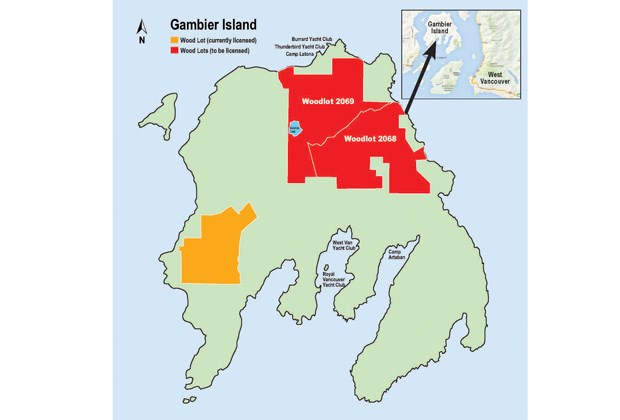A group of North Shore residents with summer cottages on Gambier Island are raising concerns about plans to log a large swath of forest they say could ruin recreational values on the island.
"It's the wilderness heart of Howe Sound, and a prime recreational jewel," said Peter Scholefield, a West Vancouver resident and president of the Gambier Island Conservancy, a group opposed to the logging.
Scholefield's is one of several hundred families who make up the majority of Gambier Island's parttime residents, most of whom are from North and West Vancouver.
Many of them have been coming to the island for generations to enjoy its beaches, hiking trails and lakes.
Scholefield said residents were shocked when they learned by accident this spring that the Ministry of Forests was putting two large areas in the northeast corner of the island up for bid as Crown woodlots. The two woodlots include areas of popular hiking trails, a community watershed, patches of old growth forest and Gambier Lake, a prime recreational destination on the island.
"Why they would put in a woodlot that encompasses that lake is beyond me," said Scholefield.
The area is close to a children's summer camp and to outstations of the Burrard and Thunderbird yacht clubs.
Combined with an existing woodlot, if the new woodlots are approved, it would see 25 per cent of the island under active logging, said Scholefield. The two new woodlots, which would be side by side, total 1,326 hectares, while the current woodlot is 400 hectares.
That's too much for a sensitive island, said Scholefield.
"We want to see the land preserved."
According to the Ministry of Forests, the woodlots are intended to be small-scale forestry operations, often run by local residents under a 20-year lease and have limits on how much timber can be logged each year. According to the ministry, the annual combined cut in the two woodlots would be 6,000 cubic metres.
District staff estimate the two new woodlots would provide between four and five jobs, said ministry spokesman Greig Bethel.
Six bids were received on each of the woodlots, ranging from a low of $100,000 to a high of $488,000.
Bethel said any successful bidder must complete a management plan, which is made available for public review and addresses issues like management of watershed, riparian areas and recreation areas.
But islanders say they have little confidence in that process, and aren't happy that they weren't consulted before the ministry advertised the two new woodlots.
"I think they need to hold off until they've properly evaluated it," said Peter Snell, a North Vancouver resident whose family owns a cottage near the proposed woodlots on the north end of Gambier.
Snell said the plan for the logging has ignored the impact on the island.
"This is one of the last remaining wilderness areas close to Vancouver," he said.
He added there's no guarantee about how much timber would be taken out each year, because woodlot operators have flexibility as long as the annual cut averages out over five years.
"We're not against forestry or economic development of regions," he said "but you have to take into account an impact on an ecosystem."
Recently some Gambier residents met with Ministry of Forests officials along with political representatives including West Vancouver Sea-to-Sky MLA Jordan Sturdy to discuss concerns.
Kate-Louise Stamford, the island trustee for Gambier, said most people on the island would prefer to see the area preserved for wilderness conservation - or at least see the woodlots significantly reduced in size.
While between 100 and 200 people are fulltime Gambier residents - including the logger who operates the existing woodlot - about 85 per cent of islanders are cottagers, said Stamford, who don't want to see its beauty destroyed.
"I recognize that we're part of B.C. and B.C. has logging as a resource," she said. "We do have a woodlot on our little island."
But with the addition of the new woodlots, "it's too big, too much," she said.



